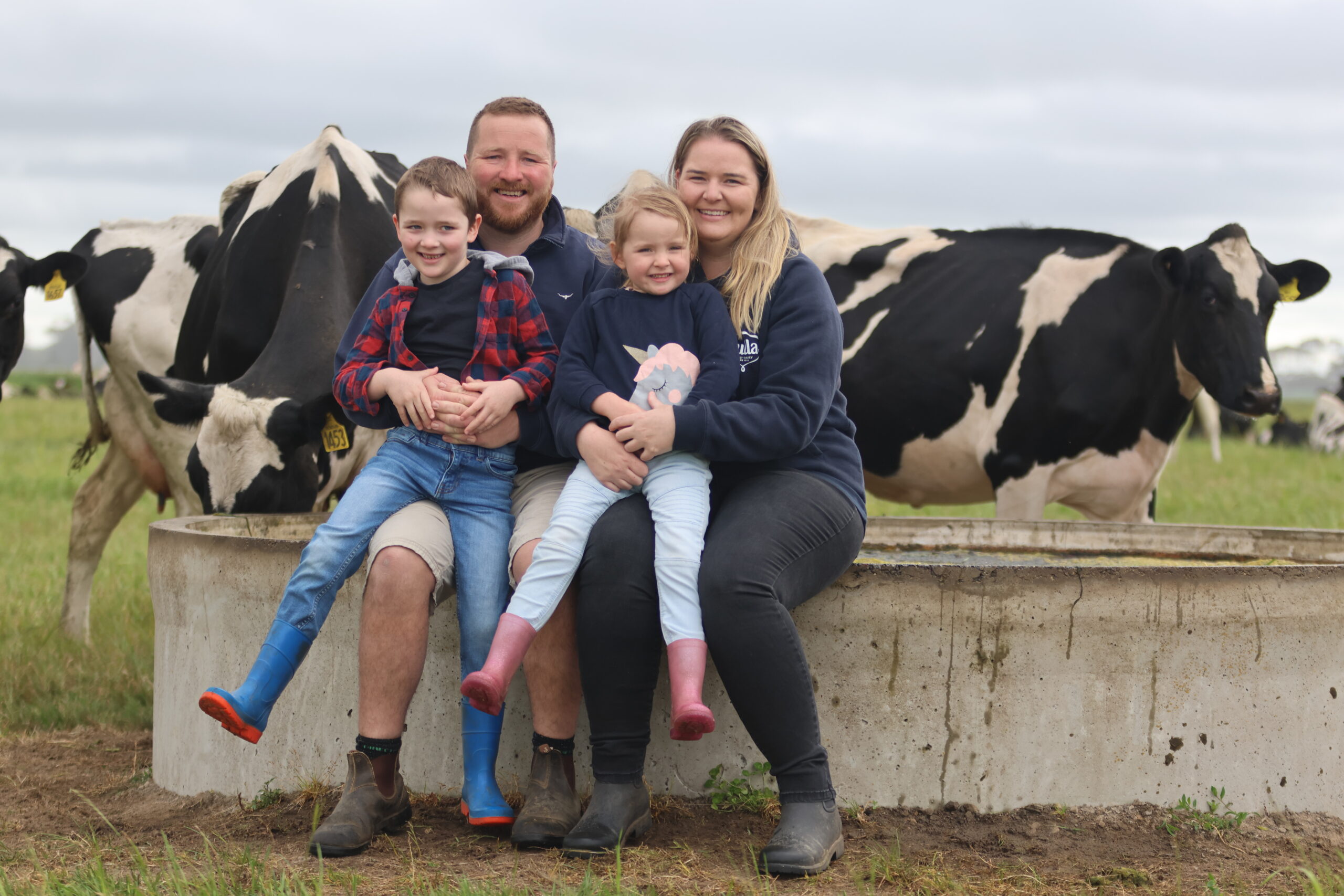Genomic analysis guides breeding decisions
Luke Davison and Victoria Burleigh
Region: South-West Victoria
Topic: Genomics
For sharefarmers Luke Davison and Victoria Burleigh genomictesting is a business tool. Like soil testing. But it’s what they do with the genomic information that makes DNA testing so valuable for the south-west Victorian farmers.
“Genomics has taken that ‘she looks nice’ away and replaced it with ‘okay, she looks nice, but her numbers aren’t flash’,” Luke explained.
“We know she probably isn’t going to be a profitable cow going forward in our system.”

Luke Davison and Victoria Burleigh say genomics has enabled them to make more data-driven breeding decisions such as which heifers to keep as replacements for their herd.
These ‘numbers’ are derived from the genomic test – an ear notch DNA sample taken from calves – and provide an insight into how these animals will perform across their productive life.
Luke and Victoria, with breeding adviser Rex Barry and farm owner Bill Dumesny, rank heifers based on DataGene’s Balanced Performance Index (BPI) and retain the highest scoring animals as replacements.
“We’ve been fortunate, the past two years, to have been able to be very selective because of sexed semen,” Luke said.
“Rex said to us, ‘if you need 110 replacement heifers, go down 110 from the top and cut the BPI off whatever that is’.”
“If we need a few more numbers, we will play around at the margins.”
This past season the cut-off was 250 BPI, which meant a lot of animals were 300 BPI or more with a couple sitting as high as 420 BPI.
Luke and Victoria with children Hazel (6), Braxton (5) and Florence (3) milk 330 cows at Nullawarre, calving once a year and an average of 650 kilograms of milk solids per cow.
It was Victoria who first heard about genomics through the Dairy Australia podcast. That was three-and-a-half years ago.
Soon the couple will begin milking their first genomic tested heifers.
Victoria said their breeding decisions were also now more data-driven after taking “a couple of years to get to this point”.
They anticipate using genomic results to guide bull selections but won’t go down the path of “individualised breeding.”
Instead, for example, if a cow has produced two poorer BPI heifers, she will be bred to specialised dairy-beef semen.
It will be the same for older cows that don’t calve during the tight seasonal six-week calving pattern.
For those joined to dairy bulls, Luke, Victoria and Bill will concentrate on selecting a few Good Bulls with high semen fertility to use across the entire herd.
DataGene Stakeholder Relations Specialist, Peter Thurn, said Luke and Victoria’s approach of selecting a team of Good Bulls with specific desired traits, is a great way to increase genetic gain.
“Some people can get too hung-up on individualising matings, but most of the work is done in the bulls you select and ensuring you avoid inbreeding,” he said.
“There was a corrective mating study done in the US many years ago that demonstrated corrective mating – or individualised mating – didn’t advance a herd any more than selecting good bulls and avoiding inbreeding.”
In addition to breeding for BPI, reducing the stature of the Holstein herd, to improve their feed efficiency and reduce paddock pugging, has been a priority for Luke, Victoria and Bill.
They also want to maintain a high in-calf result through the use of high semen fertility bulls to breed heifers.
Their most recent sexed semen heifer fixed time artificial insemination program delivered “an exceptional joining” conception rate of 78%.
Previously they’ve averaged 55-60%.
Heifer management underpins these results with monthly weighing helping track their progress before they are joined at 350 kilograms.
Continual improvement is a theme of Luke and Victoria’s farming journey.
The couple began dairy farming after establishing careers outside the sector – Victoria as a teacher and Luke as an agronomist.
They’ve since purchased a beef property, with dairy farm ownership their end-goal.
Victoria said this combination of ‘starting from scratch’ and previous study gave them a thirst for knowledge, and they actively sought information through networks and industry bodies.
“Knowledge is power,” she said. “We’ve really immersed ourselves in information we can get from anywhere to make our dream a reality. We’ve done courses through Dairy Australia and other bodies, the more we know, the better we can do.”


